Montrachet Wines
The Montrachet appellation covers a total area of 8 hectares. Montrachet is located in between the Chassagne-Montrachet and Puligny-Montrachet communes. Montrachet is one of the 5 "Grand Cru"...Read More



















Montrachet Wine | Cradle of World-Class Burgundy Chardonnay
To open a bottle of Montrachet is a transcendent experience, akin to a live performance of the Vienna Philharmonic or a quiet, introspective viewing of the Aurora Borealis. This Grand Cru gemstone of Burgundy measures just under 20 acres in total, divided between two dozen of the region’s most iconic producers. On southeast-facing slopes, densely planted vines stretch their roots deep into limestone soils with swirls of marl and manganese, producing a very low yield of highly concentrated fruit.
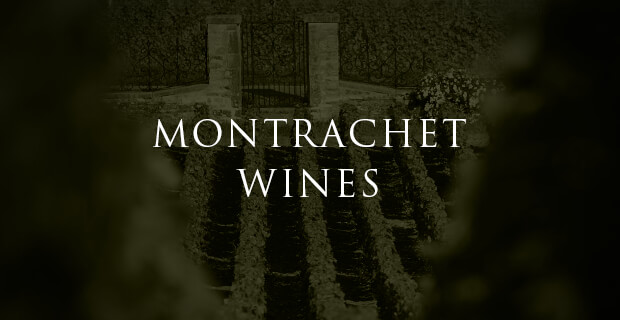
Coaxed gently out of these fine grapes is a tremendously authentic expression of this prized terroir, revealing a purity and finesse sans pareil. With its brilliant gold hue that deepens with age, its bouquet of dried white fruit, honeyed almonds, spice and smoke with warm, buttered croissant, and its generous, unctuous, mouth-coating texture, Montrachet is the pinnacle of Burgundy in white from the undisputed birthplace of Chardonnay.
The History of Montrachet Wine
The Montrachet wine region in Burgundy’s Cote de Beaune boasts an impressive winemaking legacy, dating back to the Middle Ages. One of the first written records of the region was left behind by the Cistercian abbey of Maizieres, who mentioned « Mont Rachaz » as being among its properties, donated to the abbey by Pierre and Arnolet de Puligny. At the end of the 14th century, Philippe II of Burgundy (also known as Philippe the Bold) confiscated the vineyard land previously owned by Jean de Chassaignes and offered them to the Carthusians of Dijon, who sold it back to Master Jean Perron in 1391. In the centuries that followed, the plots of the Montrachet wine area were passed from one family to another, from one generation to the next. They were partially seized as national property by the state following the French Revolution, but eventually resold at auction to various families.
In 1855, the Montrachet wine growing region expanded over 3 hectares, 95 ares and 30 centiares, according to Dr. Jules Lavalle, the writer responsible for unofficially codifying the terroir of Burgundy. In 1921, the court of Beaune defined the boundaries of the Montrachet appellation of origin. This became official on July 31, 1937, when Montrachet was granted Appellation d’Origine Controlée (AOC) status and recognised as a Grand Cru appellation of Burgundy.
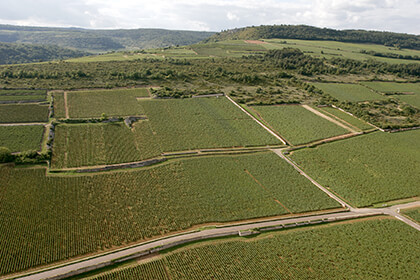
By this time, Montrachet wines had achieved a stellar reputation, resulting from the hard work and know-how of the winemakers based here. The appellation rules set for Montrachet wine were quite strict, although their introduction did not change too much for these winemakers, who had already set very high standards for production. Exclusively the Chardonnay grape could be used, with the minimum sugar content of the must set at 212 grams per litre, the maximum yield set at 30 hL/ hectare and minimum alcoholic degrees set at 12.5°.
Today, Montrachet wine must still be produced from 100% Chardonnay. The vines must be planted at a minimum density of 9000 vines per hectare. Target yield is set to 48 hL per hectare, minimum sugar content of the must to 187 grams per litre and maximum alcoholic strength by volume 14.5%. Montrachet wine must be aged at least until the 15th of June of the year following the harvest. The appellation is home to some of the greatest names in Burgundy winemaking, including Bouchard Pere et Fils, Jacques Prieur and Joseph Drouhin.
The Terroir of Montrachet Wine
Montrachet is an AOC Grand Cru appellation situated in the southernmost area of the Côte de Beaune in the Burgundy wine region of France. It is bordered by Meursault in the north and Santenay in the south. The vineyards of Montrachet can be found on the mid-slope of the Montrachet Hill, straddling the communes (or villages) of Puligny-Montrachet and Chassagne-Montrachet, known for its exquisite Burgundy white wines. In fact, the boundaries of the two communes are easy to see, as the vines on the Puligny side (referred to as Montrachet) run from east to west, while the vines on the Chassagne side (referred to as Le Montrachet) are planted in a north to south orientation.
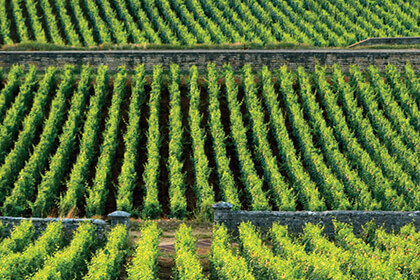
Montrachet wine belongs to a family of five distinct Grands Crus, all of which have the word “Montrachet” in their title but should not be confused with Montrachet. The four other Grand Cru appellations in the family are Batard-Montrachet (also shared by the two communes), Chevalier-Montrachet (in the commune of Puligny-Montrachet), Bienvenues-Bâtard-Montrachet (also in the commune of Puligny-Montrachet) and Criots-Bâtard-Montrachet (in the commune of Chassagne-Montrachet).
Out of this family of Grands Crus, Montrachet is the oldest and the second largest, with a total of 8 hectares (or 19.7 acres) planted to the vine. The vines enjoy east, south and southeast orientations with plenty of exposure to sunshine, which allows the grapes to ripen fully in time for the harvest. The vines are planted at an average elevation of 840 ft (256 m) above sea level. The appellation is characterised by a continental climate with cold, dry winters and warm summer months.
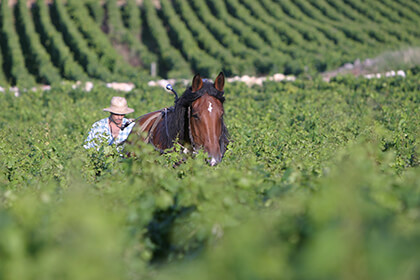
As is the case throughout Burgundy, the quality of the wines is attributed to the characteristics of the soil found in the vineyard. The Montrachet wine terroir features thin and stony topsoil over a thick subsoil of limestone, with a significant proportion of reddish marl and manganese. This limestone subsoil offers excellent water drainage, quickly eliminating any excess water. The vines are forced to stretch their roots very deep into the soil in search of water, which results in stunning complexity in the finished wines. This limestone soil also helps reflect light up through the vine canopy, helping the grapes ripen fully.
As in many other appellations of Burgundy, viticultural in the Montrachet wine appellation tends to be traditional and organic, with more and more biodynamic practices employed. Chemical fertilisers have been completely eliminating and horses are typically used instead of tractors for a more delicate ploughing of the soil. The Grand Cru vineyard plots of Montrachet are planted exclusively with Chardonnay, the flagship white grape of the Burgundy wine region. (The flagship red grape of Burgundy is Pinot Noir, not found in Montrachet.)
Winemaking in the Montrachet Wine Appellation
The vineyards of the Grand Cru Montrachet are divided between several world-renowned Burgundy producers, each one with a signature style and unique winemaking preferences. Nevertheless, the major steps of Montrachet wine production are consistent across the appellation. The fruit is harvested manually and placed into small open crates to avoid excessive crushing. They are sorted first in the Montrachet vineyard at picking and later on sorting tables upon arrival at the winery. The grapes are pressed very slowly and carefully, and the juices filled into barrels for fermentation.
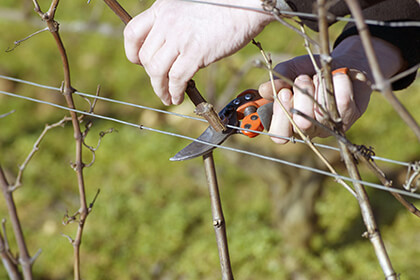
The white wines of Montrachet tend to mature for a period of 15 to 18 months in French oak barrels. These barrels tend to be third-fill or older, to avoid too much oak effect on the wines and to maintain the freshness and purity of the fruit in the finished wines.
The Signature Style of Montrachet Wine
Montrachet wine is today considered to be one of the best (if not the best) expressions of the Chardonnay grape in the world, making it one of the most sought-after white wines. While style will vary based on micro-terroir and producer preferences, these legendary white Burgundy wines tend to have some characteristics in common. In the glass, they display a bright gold colour, sometimes with greenish reflections, which tend towards dark yellow over time spent ageing in bottle.
On the nose, these dry white wines reveal an explosive bouquet of dried white fruits (peaches, pears and some citrus), nuts (almonds and hazelnuts), spices and honey, along with signature aromas of warm, buttery croissant and some earthy nuances, like truffle. The body on the palate is concentrated and structured, with flavours harmonious with the aromas on the nose. Montrachet wines seduce with their generous, unctuous, mouth-coating texture.
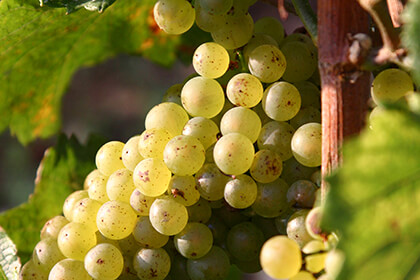
Such a powerful and generous wine deserves a sophisticated, refined and complex food pairing. We recommend serving a Montrachet wine with dishes like foie gras, juicy lobster, large prawns or monkfish. They will also go beautifully with free-range poultry or veal, especially when coated with a creamy mushroom sauce, whose richness will be perfectly cut by the wine’s subtle acidity. Serve your Montrachet wine at 53 to 57°F (or 12 to 14°C). A perfect example of a white wine built to age, most Grand Cru Montrachet wines have the potential to age 5 to 15+ years, depending on the vintage and producer.